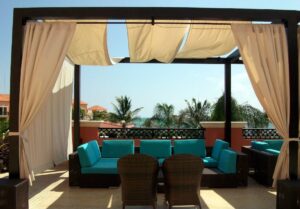7 Outdoor Patio Design Ideas to Revamp Your Outdoor Living
Guest Post by Rebecca Lee
Picturing lively parties under the starlit skies while smoke from a BBQ grill tantalises your tastebuds?
Or a cosy, louvred nook where you can hide from the sun and read a book?
That’s exactly what patios can do for you.
Patios are more than functional spaces.
They’re havens of relaxation, inspiration, and entertainment.
Unfortunately, making your patio the heart of your social sphere is a little challenging.
Looking for ideas to jog your brain? Let’s check out 7 patio design ideas that can take your retreat from forgot-it-existed to use-all-year-round.
1. Louvred Patio
If the weather in your neck of the woods is fickle like the sea, a louvred roofed patio is just the thing you need.
Created from shutters or blinds with horizontal slats, these smart shading systems open and close at the tap of a button, regulating light and blocking rain when needed.
Plus, you can get them in any colour you want, from black and blue.
This can help you compliment your patio’s decor while keeping yourself safe from harmful UV radiation, which causes 95% of all skin cancers in Australia.
Also, louvred covers are available in different styles, such as flat, sloping, and A-frame, enabling you to match aesthetics with function.
However, you’ll have to regularly clean these shading systems every few months to keep them looking new.
You can check out Trueline’s outdoor patio designs for more information on this patio design.
2. Aluminium Patio
An aluminium patio roof is an excellent option if you’re looking for a low-maintenance, durable, and three times stronger alternative to wood, which is prone to getting mushy and rotting, especially if exposed to water for long periods of time.
Plus, aluminium doesn’t fade under the sun, rust when rained upon, and weathers slowly because of its corrosion-resistant protective oxide film, which means it’ll outlast wooden patio covers by at least half a decade.
However, aluminium is three times heavier than wood, meaning you’ll have to invest in reinforced pillars for your patio.
It’s also more expensive and can quickly corrode if exposed to salt water or acid rain for long periods of time.
3. Steel Patio
If you’ve got a backyard-sized patio you want to turn into a space for family gatherings but are looking for indestructible options, steel is going to be your best friend.
It’s strong, can withstand heavy rain, snowfall, and freezing temperatures, and is resistant to wear.
Plus, if combined with metals like chromium or nickel, steel can become almost immune to oxidation, a process that causes rusting and corrosion.
This means a well-built steel patio roof or furniture can last for decades if properly cared for.
However, steel can cost a pretty penny and weighs a ton — at least one-third heavier than aluminium, which is already three times as heavy as wood.
Keep that in mind when looking for steel roofing, pillars, or furniture.
4. Insulated Patio
While steel and aluminium are some of the most durable patio materials around, they get hot — like, burn-yourself-to-the-touch hot. Plus, they sound deafening in a hailstorm or heavy rainfall, which is not great.
That’s where insulated patios save the day.
These patios have a thick layer of polystyrene foam between the ceiling (the topmost part of your patio) and the roof (the part you see when you look up).
This layer stops your patio from becoming a toaster oven, protects you from harmful UV radiation, and muffles sound, creating a cool, relaxing haven, even on scorching hot days.
However, insulated roofs can cost much more compared to non-insulated options, take more time to put together, and don’t offer much in the way of colour choices.
5. Concrete Patio
Concrete is one of the most versatile options on this list.
It’s affordable compared to a wood patio — typically costing $50 to $150 per square metre — as well as strong and durable, lasting upwards of 30 years if properly maintained.
And unlike paving stones, you won’t have to deal with grass and weeds sprouting from joints.
Plus, you can make concrete floors look gorgeous without needing to shell out lots of money, such as through acid staining, polishing, resin pouring, dyeing, and painting.
You can also pour epoxy into any cracks and crevices on your concrete floor or to level the surface.
Since epoxy comes in various colours, you can create unique designs on your floor while keeping it water-resistant.
However, concrete does have disadvantages.
For instance, it can easily develop cracks if the undersurface shifts due to heat waves or long periods of drought.
These can be costly and time-consuming to repair.
6. Patio Pavers
 If you like texture and want your patio to look eye-catching, patio pavers — paving stones created from stone, concrete, or other materials — are a good choice.
If you like texture and want your patio to look eye-catching, patio pavers — paving stones created from stone, concrete, or other materials — are a good choice.
They come in various shapes and sizes and are easy to install.
Plus, pavers can last for 20 to 25 years without needing major repairs if made from stone, concrete, or porcelain.
They also don’t crack when exposed to heat, which means you can get a fire pit if you want!
However, patio pavers can be expensive compared to concrete because they’re more time-consuming and labour-intensive to install.
7. Tile
Tiles are an excellent option for your patio floor because they’re made to last and are easy to maintain.
Plus, they come in millions of designs and styles, from polka-dotted and striated to solid-coloured.
This means you can stay stylish while fitting for function.
Unfortunately, tiles can be expensive to put in because they’re labour-intensive and difficult to install outdoors.
They’re also brittle — a dumbbell can easily crack them — and can be slippery in the presence of water, which makes them a hazard.
